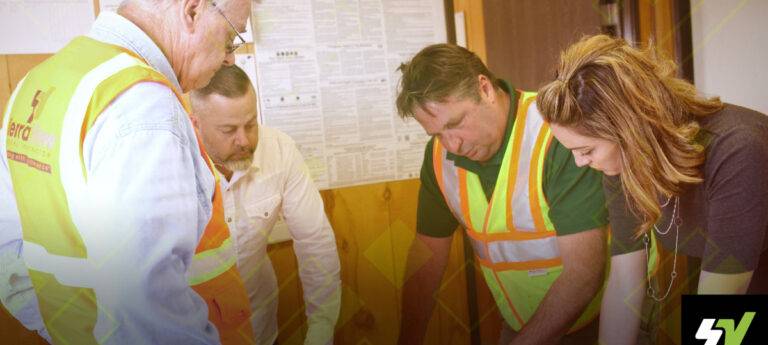In returning to the second installment of this two-part series (read part one), we investigate technology’s effect on safety protocol for construction workers when it comes to performing their daily functions.
The technology reviewed here mainly plays a part in managing social distancing while maintaining effective communication. Primarily, in the techniques we investigate, Zoom video meetings or Slack messaging can provide a virtual way to contact your teams remotely.
Additionally, tracking updates from organizations such as the American Institute of Architects (AIA) or the Occupational Safety and Health Administration (OSHA) is as simple as having a quick and reliable internet connection with which to stay connected. As a result, you can be an effective, proficient leader while navigating the challenges many companies are facing.
Certainly, regular, recurrent meetings are a standard best practice that supports ongoing safety and maintaining new practices. Consider implementing three different styles: new project safety meetings, staff training, and toolbox talks. These may sound similar, but they are intended to serve different purposes.
In general, hold new project safety meetings before beginning work on a new job site. These facilitate the delivery of information regardless of various teams’ geographical location or the number of team members you need to reach. Require all employees to attend a virtual meeting at a designated time.
To create a proper sense of importance and urgency, include a digital document that records attendance. The discussion should include risks or workplace hazards that may be present throughout any stage of construction. Equally important, you will also need to acknowledge any new technology in place for the workers such as drones, wearable body temperature monitors, or new workflow tools. Visit part one of this post for more on different types of technology suited for worksites.
Next, staff training is one of the most successful ways to initiate and to maintain communication in an ever-adapting environment. Use safety training to update and educate the staff on safe work practices.
The sessions are ideal for getting workers acquainted with new safety exercises or ongoing training regulations, or they can serve as a refresher course. From recognizing hazards or unsafe working conditions to PPE (Personal Protective Equipment) requirements and the review of corrective measures for failing to carry out protocol, make adjustments as needed for this more formal type of meeting. Appointing a specific staff member to be responsible for communicating OSHA updates would be incredibly beneficial as well.
Likewise, toolbox talks to strengthen a culture of safety awareness and cultivate a commitment to protecting your workers. With these quick check-ins, you will be able to reinforce basic safety and inform staff of any changes to the worksite or working conditions. Short and informal, this is an opportunity to check in with workers’ daily experiences and equipment inspection. After all, we can agree that worker safety should be the number one priority of every construction company.
Because these chats are happening more frequently, they should take place safely among smaller groups of workers. Messaging applications such as Slack allow quick and easy distribution of information. Design a “call tree” for site managers to toolbox talk leaders as a way to send priority topics that are relevant to what’s happening on-site that day. If any injuries or accidents have taken place, use this opportunity to share the event and discuss how it could have been prevented. Use any recorded site inspections (such as drone footage) as teaching opportunities, positive reinforcement, and topics for these talks.
Now, as employers, public officials, or designers review the challenges ahead of them, their strategies can help businesses, including construction, reopen safely. Communities need guidance for safely reopening buildings, and the AIA has released resources to help. The AIA created outlines that greatly assist in decision making for companies and professionals. With this intention, the AIA gathered a team of architects, public health experts, engineers, and facility managers to create guidelines for operating during a pandemic and to implement these new considerations as future public health and safety standards.
Thus, the focus was on reducing the spread of pathogens, accommodating physical distancing, promoting mental health, and fulfilling both operational and functional expectations. These plans include the Risk Management Plan for Buildings, the AIA Re-Occupancy Assessment Tool 2.1, and the COVID-19 ArchMap — each available as an online resource.
The Risk Management Plan for Buildings is a seven-step plan that assists with assessing hazards, applying architectural or engineering strategies, and reducing risk.
The AIA Re-Occupancy Assessment Tool 2.1 provides a framework for re-occupancy throughout the entire transition process from complete closure to full operation. This tool lists the baseline parameters for re-occupancy, various needs and trades for the site, administrative policies to reduce pathogen spread, and procedures related to PPE.
The COVID-19 ArchMap is a continuously updated interactive map that gives information on responding to healthcare facilities around the globe, helping health agencies identify appropriate adaptive sites for patient care. In the search for available beds, they targeted public convention centers, sports arenas, hotels, and more, so you can enjoy the advantage of locating these from a single place on the internet.
By fitting these meetings and resources into your business model, you will be learning skills as a team and also maintaining individual accountability. As you arm your workers with these adaptive safety measures, available technology supports their performance.
Employers and staff alike can be confident with these protocols in place. Protecting one of your most substantial assets —the team— will continue to be an investment in good business. This attitude helps Sierra View uphold our goal to deliver projects with integrity, honesty, and customer satisfaction within the commercial construction industry. By following these suggestions from Sierra View, you will create a harmonious and healthy workplace fit for longevity.
